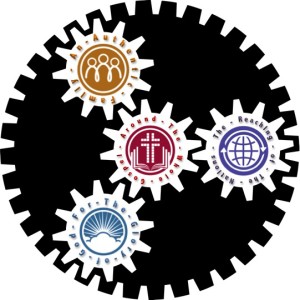 Matthew 5
Matthew 5
9 Blessed are the peacemakers, for they shall be called sons of God.
Chuck Lawless has written about Cottonwood Church of Albuquerque, New Mexico, and their process of accepting new members. In the process, the church does something interesting. It communicates a commitment to peacemaking. Here is what they say:
Since we are all sinners saved by grace, we hurt each other. Successful church members make a habit of taking the initiative to clear up hurt feelings and damaged relationships. By so doing, they keep their friendships intact and their emotions healthy through the years…All the leaders at Cottonwood Church commit to reconciling relationships in harmony with Christian principles found in Matthew 5:21-26 and Matthew 18:15-20. At Cottonwood, we’ve made a commitment to being a peacemaking church![1]
This is a very interesting statement containing some intriguing elements. One is the assumption that human beings will inevitably hurt one another in certain ways, even in the context of the Church. Another is that combating this takes initiative and deliberate care. Another assumption is that Jesus has shown us how to do life together and how to handle offenses when they occur. Finally there is a clear commitment to peacemaking.
I believe this church is on the right track and is doing something we should seriously consider. We too should “make a commitment to being a peacemaking church!”
As we approach this idea of being peacemakers – an idea that we get from Jesus’ explicit words to this effect in Matthew 5:9 – we will first consider the nature of human community and the ways in which God equips us to handle conflicts. We will then spell out some very specific ways that we can act as peacemakers in the church.
Human beings are designed for community, though these communities are now fallen and therefore inevitably drift toward conflict and dissolution.
Let us begin by noting two biblical assumptions: (1) we were made for community and (2) our communities inevitably conflict because of human fallenness.
We find the first assumption in Genesis 2.
18a Then the Lord God said, “It is not good that the man should be alone…”
In its immediate context, this is a preparatory statement for the first marriage in human history. However, there is also a basic anthropological statement here. “It is not good that the man should be alone” also refers to the basic and inherent need for community in any individual’s life. No man is an island. God did not intend for us to be alone.

In his book, Renovation of the Heart, Dallas Willard wrote of the basic need for community.
The natural condition of life for human beings is one of reciprocal rootedness in others. As firmness of footing is a condition of walking and secure movement, so assurance of others being for us is the condition of stable, healthy living. There are many ways this can be present in individual cases, but it must be there. If it is not, we are but walking wounded, our life more or less a shambles until we die.[2]
We are social creatures created for society, be it the society of marriage or simply society at large. However, human society on this side of Eden is necessarily fallen society. As such, conflicts are bred within it and erupt here and there to the detriment of peaceful community. In James 4, James diagnoses the source of such conflicts.
1 What causes quarrels and what causes fights among you? Is it not this, that your passions are at war within you?
This is so. The seeds of the corruption of human community are found in the fallenness of human nature.
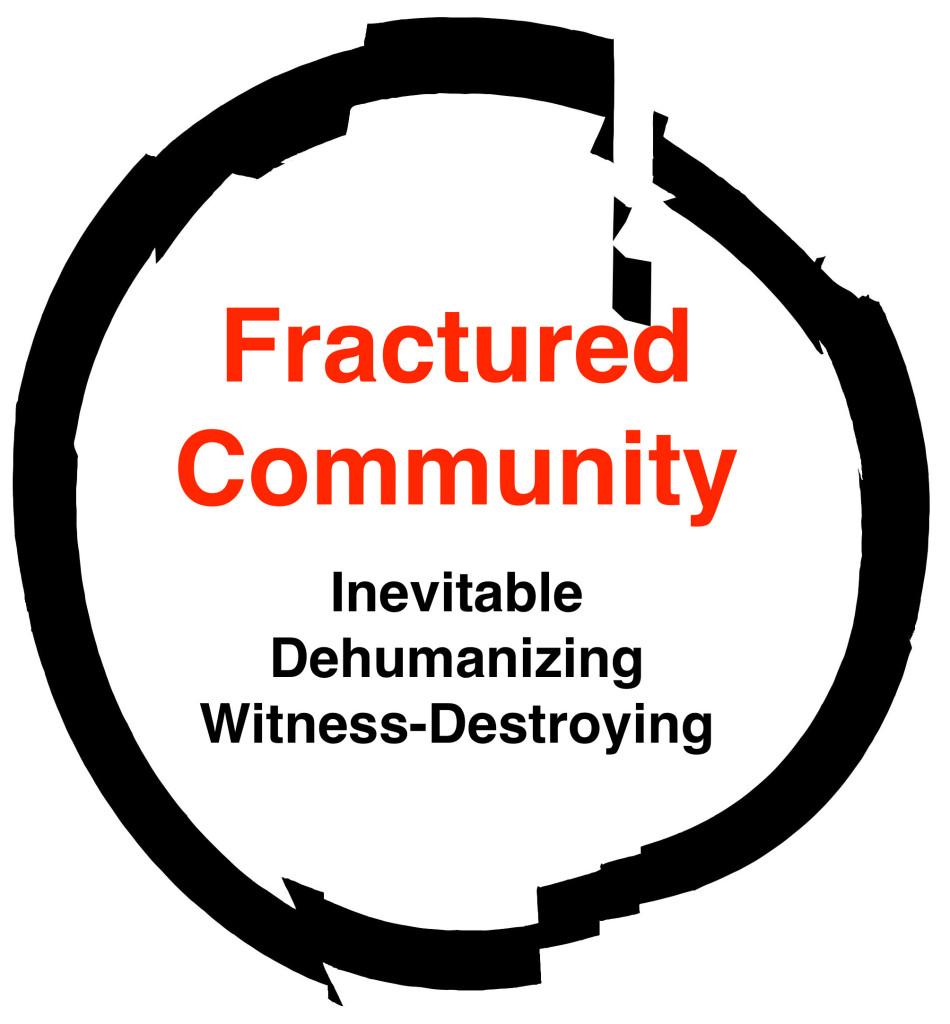
To the extent that Christians still battle with sin we still battle therefore with the potential for conflict and the fracturing of human society. Dietrich Bonhoeffer put it like this:
One person is fundamentally alien to the other. Status hominum naturalis est bellum omnium contra omnes [The natural human state is war of every one against every one] (Hobbes). This is the basis for all social forms; thus they should be interpreted as purely contractual.[3]
Perhaps you think this is an overstatement. Let me ask you, then: would your experience lead you to conclude that the natural human state is peace? Surely not. No, we naturally drift toward conflict.
I think one of the most interesting and helpful ways I have heard this put is in Dallas Willard’s concept of “assault and withdrawal.”

Here is what Willard says:
The exact nature of the poison of sin in our social dimension is fairly easy to describe, though extremely hard to deal with. It has two forms. They are so closely related that they really are two forms of the same thing: of lovelessness, lack of proper regard and care for others. These two forms are assault or attack and withdrawal or “distancing.” They are so much a part of ordinary human existence that most people think they are just “reality,” and never imagine that we could live without them. If spiritual formation in Christ is to succeed, the power of these two forms of evil in our own life— within our self— absolutely must be broken.[4]
Perhaps you have seen this dynamic at work. We begin with human community, with people trying to live life together. Perhaps the community was voluntarily entered into by the participants. Perhaps it was a product of biology: you were born into it. Regardless, in the context of community, an offense, whether real or perceived occurs. The offense is seen, it is processed, it is evaluated. Or perhaps it is not. Perhaps it is sudden, perhaps even violent. Perhaps the response to it is impulsive instead of deliberate. Regardless, there is an offense and this gives way to assault or attack. Two bodies collide. It can be a mutual attack or maybe it is one-sided. However it happens, there is offense, there is assault, then there is withdrawal. The parties withdraw, first into their circles of support who will believe their particular version of the narrative, and then maybe even further: withdrawal into the self, withdrawal from the very idea of community.
Willard’s description should be seen as broad brush strokes. There are countless nuances and qualifications that might be made, but the exceptions only prove the rule. Human beings in the context of society perceive an offense, collide, then ricochet back into themselves.
In the context of church life, sometimes this plays out with parties. Groups take offense, groups assault, and groups withdrawal. The withdrawal is either into factions or into the creation of another church.
This is the cycle that must be broken. The cycle must first be perceived and then the cycle must be broken.
The only way to heal the inevitably-broken circle of human community is to allow it to be transformed by an unbroken circle of a community outside and above it.
But how is the cycle broken? If the circle of human community, even the divinely founded and empowered community of the redeemed, the Church, tends toward fracturing, how can the cycle be broken?
The only way to heal the inevitably-broken circle of human community is to allow it to be transformed by an unbroken circle of community outside and above it.
Put another way, what if we had a model of community in which there had literally never been dissolution, had literally never been the assault/withdrawal dynamic, and had literally never been a break in the circle?
Here is where Christianity in particular offers something that no other claim to truth can offer. I am speaking of the Trinity, of the relationship between the Father, the Son, and the Holy Spirit.
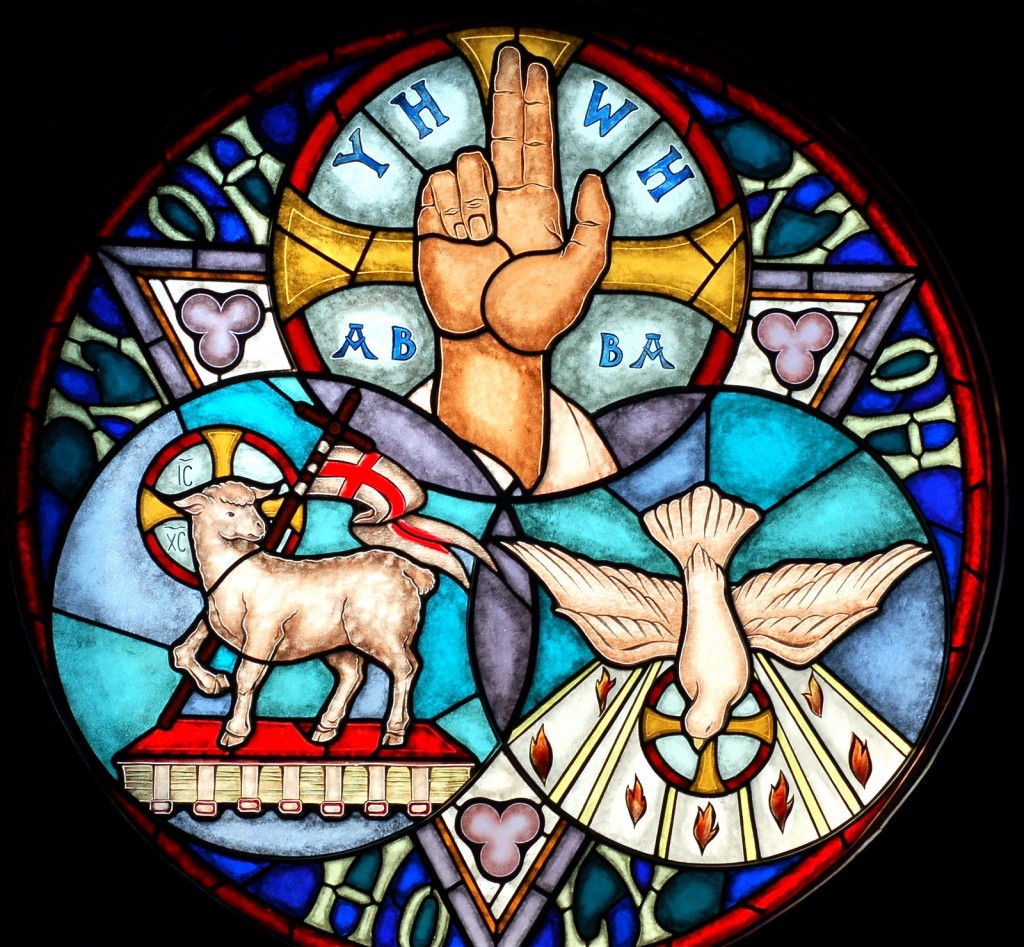
The Trinity is simply the inevitable result of the Christian belief that God is one and that the Father, the Son, and the Holy Spirit are God. This is not the place to unpack all that this means, but it does mean, properly understood, that there is, in a sense, community within the one triune God, that is, community between the Father, Son, and Spirit. More than that, it means that the relationship within God serves as the perfect community, an unbroken circle that alone can show us the way forward.
It just so happens that Jesus pointed to precisely this idea in the High Priestly Prayer of John 17.
20 “I do not ask for these only, but also for those who will believe in me through their word, 21 that they may all be one, just as you, Father, are in me, and I in you, that they also may be in us, so that the world may believe that you have sent me. 22 The glory that you have given me I have given to them, that they may be one even as we are one, 23 I in them and you in me, that they may become perfectly one, so that the world may know that you sent me and loved them even as you loved me.
The relationship of the Father and Son serves as a model for the relationship that all followers of Jesus should have.
John Stott once passed on a fascinating and troubling statement made to him by a professor of psychiatry at a major university.
Some years ago I had the opportunity of meeting and speaking with Dr. Hobart Mowrer, Emeritus Professor Psychiatry at the University of Illinois. He was well known in his day. He was not a Christian, he told me, and had a lover’s quarrel with the church. Why? Because, he said, the church had failed him as a young man and continued to fail his patients today. And he added: “The church has never learned the secret of community.” His answer is one of the most damning criticisms of the church I have ever read. For the church is community, living stones in the building of God.[5]
It is indeed a damning statement, for Christians are people who have, through the finished work of Christ, been restored in loving relationship with the triune God. The indwelling power of the Holy Spirit within and among us is therefore ever and always seeking to manifest and display among us the exact same love and relationship and harmony that exists within the divine three-in-one community of the Holy Trinity. In other words, the God who is Trinity is the God whose sovereign reign and rule and relationality should be holding sway here among us right now!
Once again, Dallas Willard puts it well when he writes:
Ultimately every human circle is doomed to dissolution if it is not caught up in the life of the only genuinely self-sufficient circle of sufficiency, that of the Father, Son, and Holy Spirit. For that circle is the only one that is truly and totally self-sufficient. And all the broken circles must ultimately find their healing there, if anywhere. Only when rooted in that divine Trinitarian circle can the broken individuals from the broken circles recover from the wounds received in their circles of origin and find wholeness on their long journey from the womb to the eternal City of God. Of course it was never God’s intention that the natural human circles of sufficiency, of reciprocal rootedness, would be illusory, fragile, and eventually broken; and if they were lived within his kingdom, they would not be.[6]
What this means, then, is we must become students of and participants in the same love and unity that exists within the triune God. So, for example, when Jesus says in John 5:19, “Truly, truly, I say to you, the Son can do nothing of his own accord, but only what he sees the Father doing. For whatever the Father does, that the Son does likewise,” that statement and that reality serves as a model for our relationship with God and one another as well. We should stand together with Jesus and pray that such might be said of us: we too, together, can only do what we see the Father doing. And when we say that together it has a unifying and healing power derived from the divine relationality of the Trinity and now operative among the people of God. So when we become this together we necessarily become it also for and with one another.
The Trinity, then, is not an obscure and difficult doctrine for theological eggheads to discuss. Rather, the relationship of the Father, the Son, and the Holy Spirit becomes the sine qua non, the “without which nothing,” of the relational identity of the followers of Jesus.
Once we bow before the triune God we can then see clearly enough and love deeply enough to do the things that make for peace.
It is only when we see, perceive, accept, and are transformed by the love of the triune, three-in-one God that we are able to begin what we would call the “practical” work of being a peacemaking. This is why Paul, in Romans 14, speaks of the believer’s understanding of and participation in the life of the Kingdom of God before he speaks of us engaging in peacemaking work.
17 For the kingdom of God is not a matter of eating and drinking but of righteousness and peace and joy in the Holy Spirit. 18 Whoever thus serves Christ is acceptable to God and approved by men. 19 So then let us pursue what makes for peace and for mutual upbuilding.
In other words, once you see what life is like in the Kingdom and once you begin to experience and walk in that life, then and only then can you “pursue what makes for peace.”
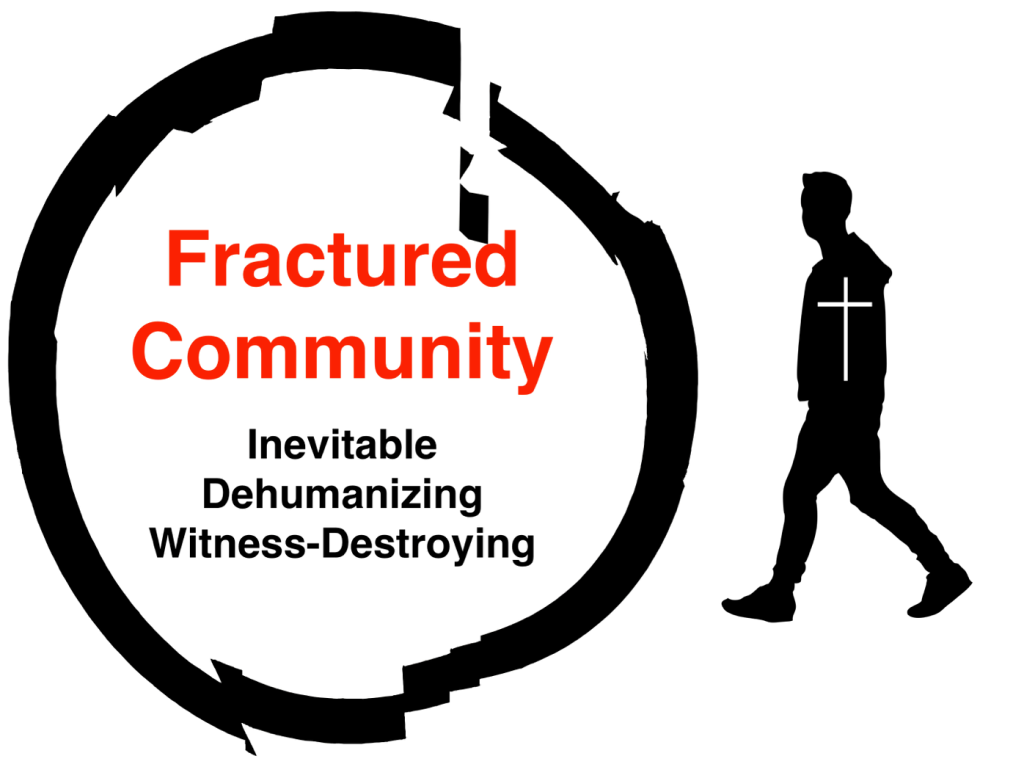
We are created for community.
But we are fallen and our communities are therefore fallen as well.
There is, however, a community within the Triune God that models for us what perfect unity and love looks like.
Through Christ we are drawn into the power and life of that divine community.
Only then are we equipped to walk towards the fractured communities of our own fallen existence and engage them with the unifying power of the gospel.
When we do this, we truly are peacemakers.
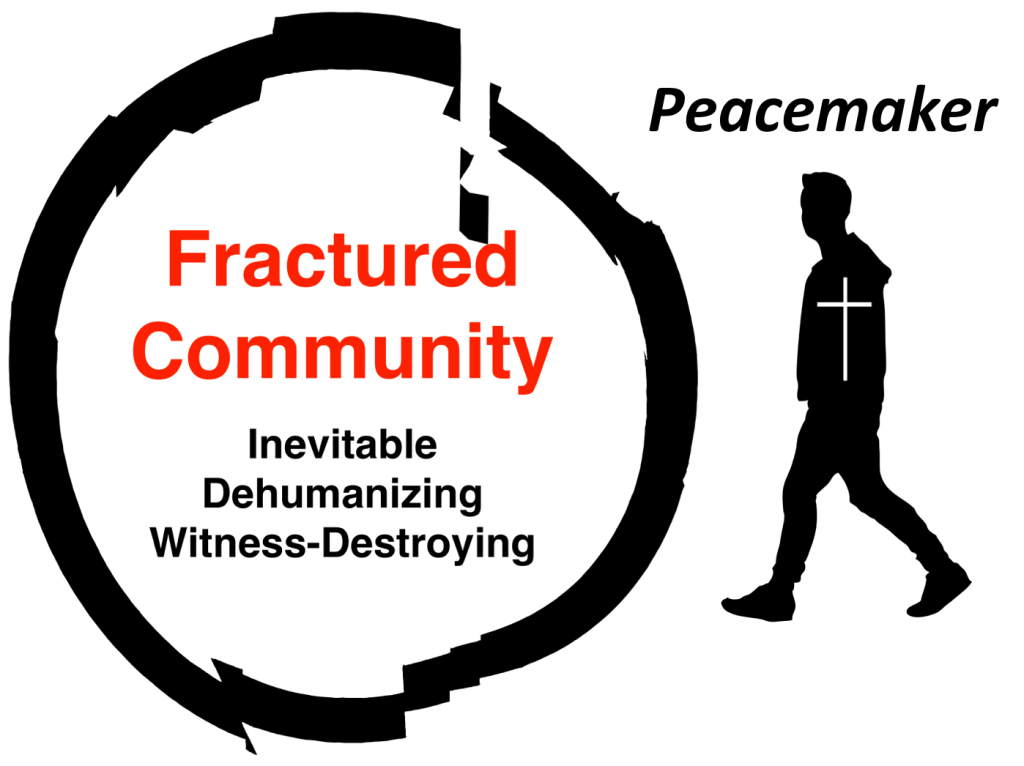
In the 3rd century, Origen said this of the Church:
The communities of God, to which Christ has become teacher and guide, are, in comparison with communities of the pagan people among whom they live as strangers, like heavenly lights in the world.[7]
That is how it ought to be. That is how it must become again. Our lives must become peacemaking lives within the community of the Church. Then, the Church itself can become a peacemaking community within the larger fractured community of the world. We do this by calling men and women and boys and girls to Jesus, who alone gives peace.
[1] Chuck Lawless, Membership Matters (Grand Rapids, MI: Zondervan, 2005), p.87.
[2] Willard, Dallas (2014-02-01). Renovation of the Heart: Putting On the Character of Christ (Kindle Locations 3572-3593). NavPress. Kindle Edition.
[3] Dietrich Bonhoeffer. Sanctorum Communio: A Theological Study of the Sociology of the Church. Dietrich Bonhoeffer Works, vol.1 (Minneapolis, MN: Fortress Press, 1998), p.39-40.
[4] Willard, Dallas, Kindle Locations 3614-3619.
[5] John Stott, The Radical Disciple (Downers Grove, IL: InterVarsity Press, 2010), p.90.
[6] Willard, Dallas, Kindle Locations 3587-3593.
[7] Willard, Dallas, Kindle Locations 3565-3567.

Pingback: Matthew | Walking Together Ministries